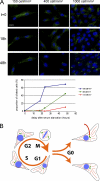Cell shape and contractility regulate ciliogenesis in cell cycle-arrested cells
- PMID: 20956379
- PMCID: PMC2958475
- DOI: 10.1083/jcb.201004003
Cell shape and contractility regulate ciliogenesis in cell cycle-arrested cells
Abstract
In most lineages, cell cycle exit is correlated with the growth of a primary cilium. We analyzed cell cycle exit and ciliogenesis in human retinal cells and found that, contrary to the classical view, not all cells exiting the cell division cycle generate a primary cilium. Using adhesive micropatterns to control individual cell spreading, we demonstrate that cell spatial confinement is a major regulator of ciliogenesis. When spatially confined, cells assemble a contractile actin network along their ventral surface and a protrusive network along their dorsal surface. The nucleus-centrosome axis in confined cells is oriented toward the dorsal surface where the primary cilium is formed. In contrast, highly spread cells assemble mostly contractile actin bundles. The nucleus-centrosome axis of spread cells is oriented toward the ventral surface, where contractility prevented primary cilium growth. These results indicate that cell geometrical confinement affects cell polarity via the modulation of actin network architecture and thereby regulates basal body positioning and primary cilium growth.
Figures





Comment in
-
Cells in tight spaces: the role of cell shape in cell function.J Cell Biol. 2010 Oct 18;191(2):233-6. doi: 10.1083/jcb.201009048. J Cell Biol. 2010. PMID: 20956377 Free PMC article.
References
-
- Alieva I.B., Gorgidze L.A., Komarova Y.A., Chernobelskaya O.A., Vorobjev I.A. 1999. Experimental model for studying the primary cilia in tissue culture cells. Membr. Cell Biol. 12:895–905 - PubMed
Publication types
MeSH terms
Substances
LinkOut - more resources
Full Text Sources
Other Literature Sources

